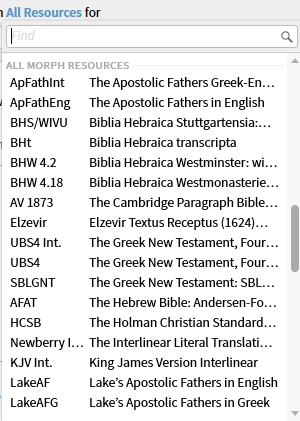Morphological Search
Updated for Logos version 10+
 = new to v10+
= new to v10+
old refers to Logos 9
Page Contents
What is a morphological search for?
You can use Morph Search to search in a Greek, Hebrew, Aramaic, or Syriac morphologically-tagged resource by the grammatical features
of a word. For example, you could find all places where the verb γινώσκω (to know) appears in the passive voice.
How do I do a morphological search?
If you use Logos 9 see old morph syntax before proceeding.
Morph Search Panel
- Open a Search panel by clicking on the magifying glass icon in the Logos toolbar.

- Select Morph as the search type if it isn’t already selected.
- click on More if it is not visible

- Click where it says “All Resources,” and choose a morphologically-tagged resource (Bible or otherwise), or a collection. In addition to original language resources, you can also do Morph searches in Reverse Interlinears. The list of morph resources will differ depending on what you’ve got in your library, but it will generally look like this (you’ll need to scroll past Collections and Series to see this list.)

- Different resources in Logos use different methods of morphological tagging, so when you select a resource you also choose a specific morphology. If you choose a collection, or multiple resources, you might involve several morphologies and the outcome of your Search would not be clear. So it is best to select the one resource you most want to search. As you gain a better understanding, your collections can be restricted to resources with the same morphology.
The most commonly used ones are these:
- Logos Greek for RI’s and Lexham Greek resources, including Septuagint (Logos’ preferred morph)
- Logos Hebrew for RI’s and Lexham Hebrew resources (Logos’ preferred morph)
- Andersen-Forbes Hebrew/Aramaic for AFAT
- WIVU Hebrew/Aramaic for BHS/WIVU resources
- Westminster Hebrew/Aramaic for BHW resources.
- Otionally select what reference range you want to limit the search to. Click where it says “All Passages” (or whatever had been selected there before) to drop down the list. Then select one of the Common Divisions or a Saved range you’ve created before, or a Passage List, or type a specific range in the “Reference range” box.
- If you wish, choose what search fields you want to limit the search to by clicking on “All Morph Text” to drop down the list and turning on the appropriate checkbox(es). This list will also vary according to what resource you’ve selected.
Search Terms
- Lemma

- Type or paste a search term, and choose the exact form of the word from the suggested matches displayed in the dropdown. The ones with a gloss are lemmas. Logos will add the appropriate prefix (lemma.x:, greek:, hebrew:, etc.) to the form of the word you choose.
- a transliterated word works well if you are not familiar with original languages e.g. h:elohim
- Morphology

- Type an @ character and a menu will drop down showing parts of speech.
The top part shows the morphology(s) of the resource. If it is followed by a down arrow, select the morphology you want.
- Choose a Part of Speech from the menu (e.g. Noun), and the menu will expand out to the right, showing you all the other options that apply to that part of speech. Select all the grammatical inflections you want to search for. You can select multiple entries in each column (no need to hold the Ctrl key down). Column selections will be AND’d and multiple row selections will be OR’d when the search is executed.
As you make your selections, you will see Logos build up the morphology codes needed for this search. You don’t need to learn these codes, but if you want to learn a few of the common ones so you can be fast at entering these queries from the keyboard, you can look them up. See Morphology Codes.
- When you’ve got the search set up the way you want it, click outside the menu.
- Combining these terms
- First enter the lemma and then the morphological term e.g. lemma.g:ἀγάπη@NG, which will find the Genitive forms of “love”.
Note that the format @NG is used here and that it can be used by itself.
After the Search
- As with other types of searches you can view the results as Passages or Verses (Logos 9), as Aligned or in Analysis view.
- If your Morph search was in Passages/Verses view, you can compare the results in different versions by clicking on Multiple books or Add Versions (Logos 9). You can type/select multiple resources, which is useful for a search on Greek or Hebrew resources as reverse interlinears enable the translation of the result to be highlighted.
- If the resource you searched was a Bible, you can click on the Charts button to see a graph of how these results are distributed throughout the Bible.
- If you find this search useful and want to mark all the search hits with some special highlighting in your resource, you can click on Save as Visual Filter in the Panel menu.
Launching a Morph search from within a resource
You can also do a morph search from within a resource, either an original language resource or a Reverse Interlinear:
- Right-click on a word
- Select the lemma or its morphology in the Context menu.
- On the other side, choose the appropriate Search option to start a Morph Search.